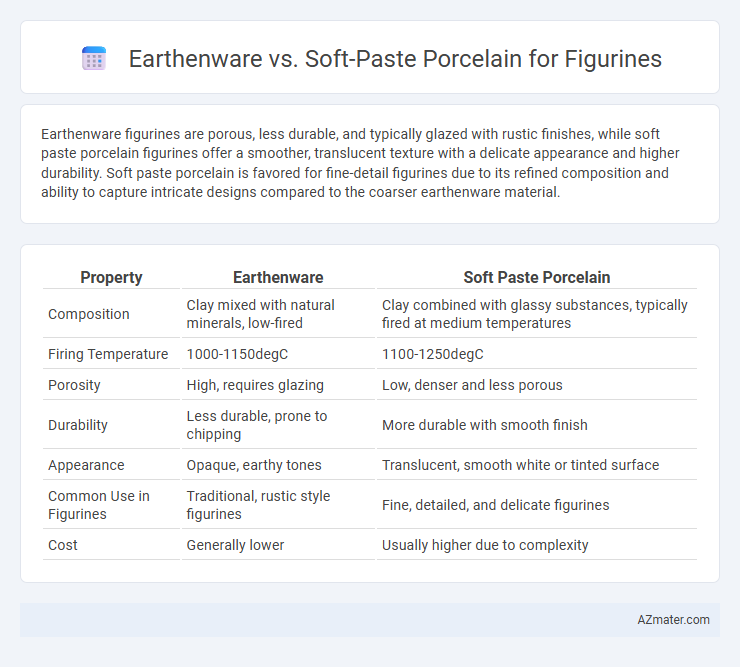Earthenware figurines are porous, less durable, and typically glazed with rustic finishes, while soft paste porcelain figurines offer a smoother, translucent texture with a delicate appearance and higher durability. Soft paste porcelain is favored for fine-detail figurines due to its refined composition and ability to capture intricate designs compared to the coarser earthenware material.
Table of Comparison
| Property | Earthenware | Soft Paste Porcelain |
|---|---|---|
| Composition | Clay mixed with natural minerals, low-fired | Clay combined with glassy substances, typically fired at medium temperatures |
| Firing Temperature | 1000-1150degC | 1100-1250degC |
| Porosity | High, requires glazing | Low, denser and less porous |
| Durability | Less durable, prone to chipping | More durable with smooth finish |
| Appearance | Opaque, earthy tones | Translucent, smooth white or tinted surface |
| Common Use in Figurines | Traditional, rustic style figurines | Fine, detailed, and delicate figurines |
| Cost | Generally lower | Usually higher due to complexity |
Introduction to Figurine Materials
Earthenware and soft paste porcelain are two common materials used for crafting figurines, each offering distinct properties that influence the final artwork's texture and durability. Earthenware, composed primarily of clay and fired at lower temperatures, tends to be more porous and opaque, making it ideal for rustic or folk-style figures. Soft paste porcelain, formulated from a mixture of clay and glassy substances and fired at higher temperatures, yields a smoother, translucent finish favored for fine, detailed figurines with delicate features.
What is Earthenware?
Earthenware is a porous ceramic material fired at lower temperatures between 1,000degC and 1,150degC, resulting in a softer, more porous texture compared to other ceramics. It is typically glazed to make it waterproof and is characterized by its rustic, earthy appearance, often used in traditional figurines for its affordability and ease of shaping. Unlike soft paste porcelain, earthenware lacks the translucency and fine detail, but offers a charming, handcrafted aesthetic favored in folk art and decorative pottery.
Understanding Soft Paste Porcelain
Soft paste porcelain, often used in figurines, is a type of ceramic material known for its delicate translucency and smooth texture, created by blending white clay with glassy substances like frit or bone ash. Unlike earthenware, which is porous and fired at lower temperatures, soft paste porcelain is fired at higher temperatures, resulting in a denser, less porous body ideal for fine details and intricate designs. Its unique composition allows for subtle color variations and a refined finish, making it highly valued in decorative art and collectible figurines.
Historical Origins of Earthenware and Soft Paste Porcelain
Earthenware originated in ancient civilizations such as Mesopotamia and Egypt, characterized by its porous texture and low firing temperatures, making it a versatile medium for early figurines. Soft paste porcelain emerged in 18th-century Europe as an attempt to replicate Chinese hard-paste porcelain, using a blend of clay and ground glass to achieve a more refined, translucent quality ideal for delicate figurine details. The historical evolution of earthenware and soft paste porcelain reflects shifts in technological advancements and cultural preferences in ceramic artistry.
Key Differences in Composition
Earthenware figurines are made from porous clay fired at lower temperatures, resulting in a coarse, less durable material often glazed for finish. Soft paste porcelain combines clay with glassy substances like frit and bone ash, fired at a moderate temperature to produce a smoother, more translucent, and refined surface. The key differences in composition directly impact durability, texture, and the level of detail achievable in figurine craftsmanship.
Production Techniques and Craftsmanship
Earthenware figurines are typically molded and fired at lower temperatures, resulting in a porous and slightly coarse texture that requires glazing for durability and detail enhancement. Soft paste porcelain figurines involve a more complex production process, combining ground glass and clay materials fired at higher temperatures to achieve a smoother, translucent finish with finer details. The craftsmanship in soft paste porcelain demands precise control of kiln conditions and skilled hand-painting, allowing for more intricate designs and delicate features compared to the sturdier but less refined earthenware.
Durability and Longevity Comparison
Earthenware figurines typically exhibit lower durability and higher porosity compared to soft paste porcelain, making them more susceptible to chipping and moisture damage over time. Soft paste porcelain, composed of feldspathic and glassy materials, offers enhanced strength and denser structure, resulting in greater longevity and resistance to wear. The vitrified surface of soft paste porcelain also helps preserve intricate details and color stability, ensuring figurines maintain their aesthetic appeal for decades.
Surface Texture and Visual Appeal
Earthenware figurines feature a porous surface texture with a matte or slightly rough finish that emphasizes rustic charm and artisanal qualities, making them suitable for earthy, traditional designs. Soft paste porcelain offers a smoother, glass-like surface with a subtle translucency, enhancing fine detail and providing a refined, glossy visual appeal ideal for delicate, elegant figurines. The choice between these materials significantly influences the tactile experience and aesthetic impact, with earthenware projecting warmth and softness, while soft paste porcelain conveys sophistication and delicacy.
Suitability for Figurine Detailing
Earthenware offers a porous and softer composition, which limits fine detailing capabilities for figurines but provides excellent depth for rustic and textured finishes. Soft paste porcelain, with its finer particle size and smoother texture, enables high precision sculpting and intricate detailing, making it ideal for delicate figurine features. The translucency and strength of soft paste porcelain enhance detailed aesthetics, while earthenware better suits robust, less intricate designs.
Choosing the Ideal Material for Figurines
Choosing the ideal material for figurines often comes down to earthenware or soft paste porcelain, each offering distinct qualities. Earthenware is valued for its durability and rustic charm, making it suitable for hand-painted designs and vibrant glazes. Soft paste porcelain, prized for its smooth texture and delicate translucency, allows for intricate detailing and a refined finish, appealing to collectors seeking elegance and finesse in figurine craftsmanship.

Infographic: Earthenware vs Soft Paste Porcelain for Figurine
 azmater.com
azmater.com